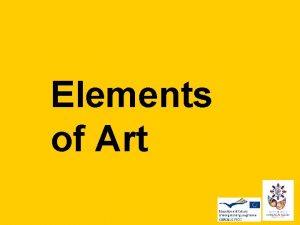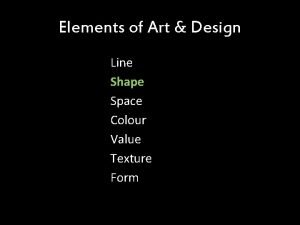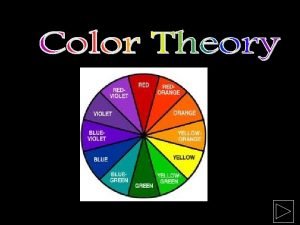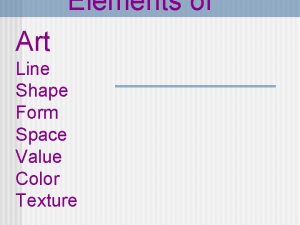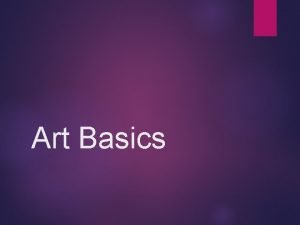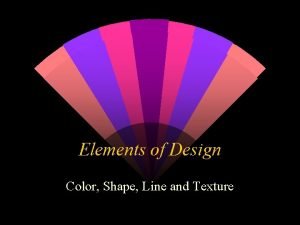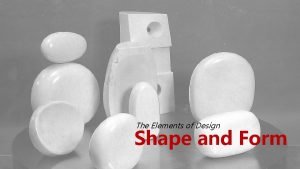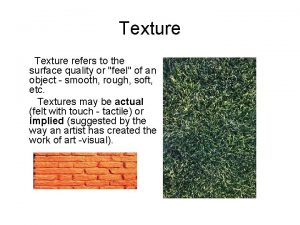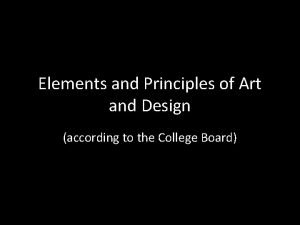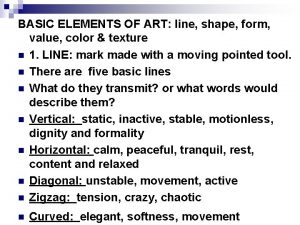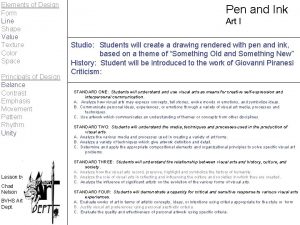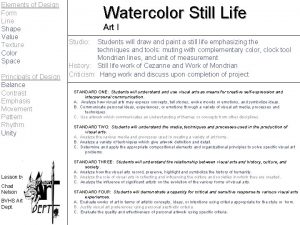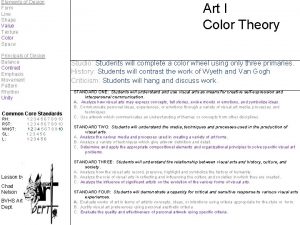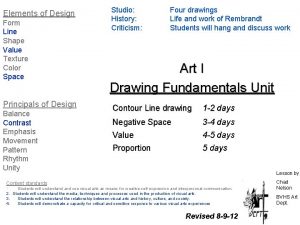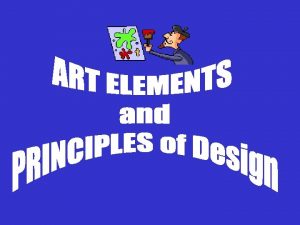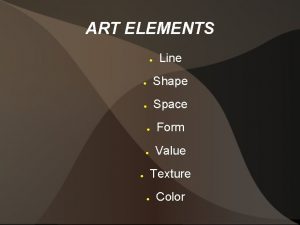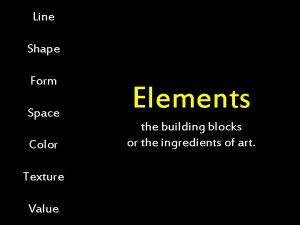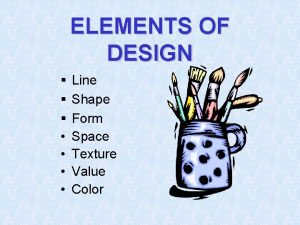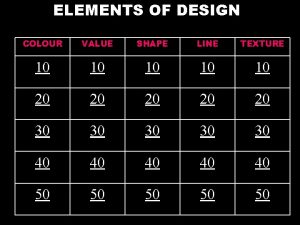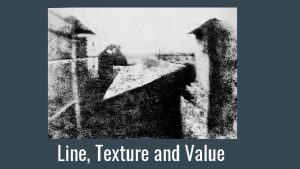Elements of Design Form Line Shape Value Texture











- Slides: 11

Elements of Design Form Line Shape Value Texture Color Space Principals of Design Balance Contrast Emphasis Movement Pattern or Repetition Rhythm Unity Art I Syllabus and Class Information Revised 8 -17 -15

Objectives Art I will introduce students to a broad range of the visual arts including the following aspects: Learning and using the Elements and Principals of Design. Using active looking and divergent thinking skills. Development of personal style and self-expression. Students will gain and expand on strong drawing fundamentals. Introduction to watercolor, pen and ink, acrylic painting, and printmaking Introduction to important artists and art history. Learning and using the vocabulary of the visual arts. Constructive evaluation of own and others’ work.

Evaluation Student projects will be graded using a point system based on the following three criteria: Meeting basic assignment objectives. Objectives will be broken into smaller chunks relative to each assignment. Presentation. 25 points Creative Effort. 25 points 50 points Semester Tests 100 points Covering terms, artists, art history and demonstrated techniques. Quizzes 20 -50 Points Writing Assignments 15 -25 Points Class Participation: 180 Points Students will automatically receive 10 points per week for being prepared, on task, and productive. Contrary behaviors will result in a reduction of participation points. *Note points on late work will be reduced by 2 points for each weekday the work is late. Late work due to excused absences will be granted an extension of 2 days per school day missed, but work must be completed out side of class time.

Rules, Regulations and Procedures A positive and relaxed environment is essential for creativity. Mean, bullying, inappropriate, and dishonest behavior will not be tolerated. Students will clean up after themselves and put materials back where they belong. Quiet talking will be permitted as long as it is appropriate and does not impede on class productivity Students will remain in assigned seats with the exception of project preparation and clean up. This includes remaining in your seat until the bell rings. Most materials will be provided to students. Supplies will be checked out, and then returned at an appointed time. Students are responsible for lost or damaged material beyond normal wear. Students will be allowed access to the supply room, but due to safety and supervision issues no student will be allowed access to the second level of the art room. Accessing the second level will be an immediate referral. Throwing or mishandling of any material in the Art Room will not be tolerated students will be warned once, if the behavior continues the student will be assigned a five page research paper in lieu of the current assignment Should a student fail to follow the rules the following procedure will be used 1. warning 2. office referral 3. student will be sent to the office For major infractions a student may be sent directly to the office

Fire, Lock Down, and Tornado Procedures In the event of a fire proceed out of the room turn right and ascend the stairs exit the school thorough the North Double Doors. Stay together, roll will be taken once outside. In the event of a lock down students will mass in the Southeast corner of the art studio near my desk. Sit down and be absolutely quiet until the all clear is given. In the event of a tornado we will exit the room using the West stairs go down to room 103 and east-west hall on lower floor (sit on knees with head between knees)

Supplies Required Number 2 Pencil or Mechanical pencil (everyday) White Eraser (everyday)

Outside of class work Iverson’s availability: During the school day you may come in and work periods 6 -8, teacher availability may be limited. M & F 3: 10 -3: 45 or later by appointment. Questions outside of class time? brian. iverson@k 12. sd. us Often before a new assignment is presented students will be asked to come up with ideas for project subject matter. This is a excellent opportunity for students to express themselves and discover their own personal style. Unfortunately if students fail to complete homework they will be assigned subject matter and lose ten points off the Creative Effort portion of the grade for that project. If you feel you are getting behind you can work on your projects outside of class. You may come in and work before, after school, or during study halls. You may also take work home, but supplies must be checked out.

Class Project Overview Negative Space Drawing 3 days Drawing Skills (pencil) Painting Skills (water color) Space Form Line Color CS II b and c Value Still Life 5 -7 days Advanced Drawing Skills (pencil) Value Contrast Shape Line Form Texture Rembrandt (Baroque Era) CS I a CS II b and c CS III c Master Study 5 -7 days Drawing Skills (pencil) Value Proportion Space Rembrandt (Baroque Era) The Power of Art: Rembrandt video Big Quiz 50 points CS II b and c CS III c CS IV a and c

Thematic Development 8 -14 days Color Wheel 5 -days Painting Skills (watercolor) Geometry Skills Measurement Skills Science of Color Drawing Skills (pencil) Color Divergent Thinking Skills Development of Personal Style Contrast Vincent van Gogh and Expression. Emphasis Movement Unity How Art Made the World: Once Upon a time Video Artist Statement 25 points CS I a, b, and c CS II b and c CS IV a, b, and c (Post Impressionism) Andrew Wyeth (American Realism) The Power of Art: Van Gogh video Name Design 5 -7 days Painting Skills (watercolor) Divergent Thinking Skills Balance Color Pattern and Repetition Movement Unity Mark Rothko (Abstract Expressionism) Paragraph contrasting Class Critique (5) responses Van Gogh and Wyeth 15 pnts. CS I a Quiz 25 points CS II c CS IV a, b, and c CS III b and c CS IV a, b, and c

Watercolor Final Class Theme Drawing Skills (pencil) Painting Skills (watercolor) Design Skills (composition) Proportion Color Value Negative Space Unity Balance Class Critique CS I a and b CS II b and c CS III a and c CS IV a and c Pen and Ink “Something Old and Something New” 8 -10 days Drawing Skills (ink & hatching) Divergent Thinking Skills (combining 2 images into 1) Design Skills (composition) Line Value Unity Balance Piranesi, Giovanni Class Critique (5) responses CS I a, b, and c CS III c CS IV a and c Printmaking 8 -14 days Drawing and Planning Skills Relief Printmaking Skills Divergent Thinking Skills Texture Contrast Value Form Balance Unity Albrecht Durer (Northern Renascence and the effects of the printing press on the historical record) The Story of Painting: The Northern Renascence video Quiz 25 points CS I a CS II a, b, and c CS III a, b, and c

Acrylic Painting 10 -16 days Drawing Skills Painting Skills (acrylic) Planning and Divergent Thinking Skills Color Texture Shape Space Form Unity Raphael and the Renaissance Monet and Impressionism The story of Painting: Italian Renaissance and Impressionism videos Reflection contrasting experiences with Watercolor and Acrylic CS I a CS II a, b, and c CS III a, b, and c Final Observational Drawing: Still Life or Interior Drawing Skills Proportion & Active Observation Planning and Divergent Thinking Skills Shape Line Proportion Space Form Unity Proportion through the ages, Gothic to Renaissance CS I c CS II a, b, and c CS IV a and c
 Line color form
Line color form The weeping woman
The weeping woman Polygon drawings line color value texture shape space form
Polygon drawings line color value texture shape space form Line shape and form
Line shape and form Elements of art and principles of design matrix
Elements of art and principles of design matrix Color shape size and texture are
Color shape size and texture are Shape and form
Shape and form Implied texture
Implied texture Apa itu value creation
Apa itu value creation Principles of art and design
Principles of art and design The basic element of art
The basic element of art A feeling of visual equality in shape form value color etc
A feeling of visual equality in shape form value color etc
